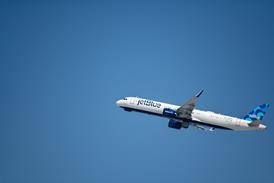Enhanced and synthetic vision systems have gone from oddity to standard fare in new cockpit designs for the smallest to largest business jets in the space of a few years. Driving the change are new integrated flightdecks with enhanced computing and display capabilities and a broadening palette of more affordable and capable systems. Combining infrared-based EVS and database-derived SVS in the same cockpit signals a desire by operators to gain better situational awareness and lower landing minima. In the longer term, there is a recognition that navigation tools for take-off and landing are shifting from the airport to the cockpit as the US Federal Aviation Administration seeks to remove costly ground infrastructure.
Rockwell Collins' new Pro Line 21 Fusion, launched at the show, will likely be the first integrated system that combines EVS and SVS into one view on the primary flight display. The company says it will build its own terrain and obstacle database for the SVS, but work with a variety of EVS vendors. Launch customer Bombardier uses a CMC Electronics cooled EVS on its Global business jet family.
Gulfstream is close to certificating Kollsman's second-generation EVS II, as well as Honeywell's synthetic-vision PFD, on the G550, which is already approved for lower approach minima using a head-up display and cooled EVS. For the Gulfstream application, SVS is not fused with EVS.
At the other end of the aircraft spectrum, Cirrus Design's single-engined personal jet will be the launch platform for L-3 Avionics Systems' SmartDeck cockpit, which will feature the company's Iris uncooled EVS on the multi-function display. SVS on the PFD is "on the roadmap for the very near future", says L-3.
Having both synthetic and enhanced vision is seen as key to what the FAA is calling equivalent visual operations (EVO). With EVO, operators will in theory be able to use EVS to view the landing environment and SVS, with an appropriate verification tool, to fill in the gaps caused by clouds, fog or snow in order to fly instrument approaches in low visibility without today's ground infrastructure. A Radio Technical Commission for Aeronautics committee is developing guidelines on how SVS and EVS could be used for EVO.
Source: Flight International




















